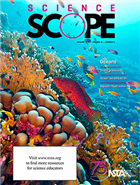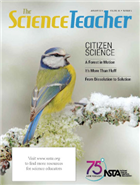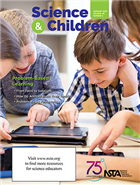Ideas and inspiration from NSTA’s January 2019 K-12 journals
By Mary Bigelow
Posted on 2019-01-07
Happy 2019! This is a milestone year for science teachers: Message From the President: NSTA’s 75th
Regardless of what grade level or subject you teach, check out all three K-12 journals. As you skim through titles and descriptions of the articles, you may find ideas for lessons that would be interesting for your students, the inspiration to adapt a lesson to your grade level or subject, or the challenge to create/share your own lessons and ideas.
NSTA members, as always, have access to the articles in all journals! Click on the links to read or add to your library.
 Science Scope – Oceans
Science Scope – Oceans
From the Editor’s Desk: Thank the Ocean “Even if you are far away from where its waves meet the shoreline, kids tend to wonder about its vast depths; rhythmic tides, interesting creatures; and the fact that there is so much left to discover…Many of our 21st-century socioscientific issues, such as climate change, plastic pollution, and oil and gas exploration, will require solutions developed by ocean literate citizens.”
Articles in this issue that describe lessons (many of which use the 5E model) include a helpful sidebar documenting the big idea, essential pre-knowledge, time, safety issues, and cost. The lessons also include connections with the NGSS.
- The lesson in Ocean Acidification Investigation is designed to help students explore and understand the relationship between air pollution and ocean acidification, including the effects on living things.
- The Microscopic World of Plankton takes a different look at food webs and ecosystems. The article includes a plankton “primer” with background information and directions for designing and constructing plankton nets—and you don’t need to live near an ocean for collecting and learning about plankton.
- Ocean Pressure connects physical science and oceanography in a hands-on study. The author includes a predict-observe-explain process in a graphic organizer.
- Commentary: Engage Your Students in Ocean Exploration Science and Scope on the Skies: Monitoring the Hydrosphere include a rationale for incorporating ocean science and water studies into the curriculum and lists of resources to get started.
- To help students understand the characteristics of saltwater, Disequilibrium: Floating Eggs has a lesson on why objects are more buoyant in salt water than in fresh water.
- Citizen Science: Global Fishing Watch is a project that shares real-time data and information on over 60,000 fishing vessels. Students can “explore, track, and measure current and historical commercial fishing activity” to look for trends and patterns.
- The investigation Staying Fit in Space combines engineering, space science, data analysis, statistics, and physics in a study of the effects of exercise on the human body in space.
This month’s Science Teacher has an article related to this theme. From Dissolution to Solution goes beyond traditional studies of ocean acidification to a series of lessons that address questions about the causes and impact of acidification and ways to reduce it.
These monthly columns continue to provide background knowledge and classroom ideas:
- Interdisciplinary Ideas: Data Literacy 101 asks “Which is the best graph to use?” and includes a helpful infographic.
- Teacher to Teacher: Using the Anchoring Phenomenon Routine to Introduce a Science Unit
- Science for All: Supplementing the Textbook Effectively to Encourage Student Growth
- Practical Research: Texts as Tools
For more on the content that provides a context for projects and strategies described in this issue, see the SciLinks topics Acid Precipitation, Buoyancy, Carbon Cycle, Density, Eclipses, Energy Transformations, Food Webs, Marine Ecosystems, Marine Life, Ocean Pollution, Ocean Water Chemistry, Oceans, Overfishing, pH Scale, Plankton, Salinity, Solutions
Many authors share resources related to the lessons and strategies in their articles. These resources include rubrics, graphic organizers, handouts, diagrams, lists of resources, and complete lessons. You can access these through the Connections link for Science Scope
Continue for The Science Teacher and Science & Children
 The Science Teacher – Citizen Science
The Science Teacher – Citizen Science
Editor’s Corner: Crowdsourcing Science “Citizen scientists monitor backyard birds, track climate change, analyze signals from space, survey invasive species, and even research what makes babies laugh… In our classes, citizen science can create opportunities for students to participate in authentic research and the generation of new scientific knowledge engaging in NGSS science and engineering practices.”
The lessons described in the articles include a chart showing connections with the NGSS. The graphics are especially helpful in understanding the activities and in providing ideas for your own investigations.
- A characteristic of citizen science projects is getting students interested in real-world science. This interest can lead to careers and lifelong interests. In these projects, teachers often learn along with students. It’s More Than Fluff describes citizen science opportunities in bird studies—collecting and submitting observational data and analyzing the data of others.
- How are tree populations responding to climate change? The citizen science project in A Forest in Motion uses Rocky Mountain National Park as a context and incorporates examples of students at work collecting and analyzing data. The authors have suggestions for adapting the project to other regions.
- It seems that the “maker movement” could be called “citizen engineering.” Making and the 5E Learning Cycle uses soap-making as a context for the process. The article has a table that illustrates how a maker-centered 5E lesson can align with NGSS practices—This would be useful for other maker projects, too.
- ADD TO SCOPE From Dissolution to Solution goes beyond traditional studies of ocean acidification to a series of lessons that address questions about the causes and impact of acidification and ways to reduce it.
- Right to the Source: Citizen Scientists in the Appalachian Forest describes a Library of Congress resource on the diversity of these forests.
Citizen Science is a monthly resource in the Scope on Science journal. This month, Citizen Science: Global Fishing Watch describes a project that shares real-time data and information on over 60,000 fishing vessels. Students can “explore, track, and measure current and historical commercial fishing activity” to look for trends and patterns.
These monthly columns continue to provide background knowledge and classroom ideas:
- Career of the Month: Civil Engineer
- Focus on Physics: Electric Power in a Parallel Circuit With an Automobile Battery
- Reaching for the Future: Building a Professional Trajectory
For more on the content that provides a context for projects and strategies described in this issue, see the SciLinks topics Biodiversity, Birds, Climate Change, Electrical Circuits, Forests, Marine Ecosystems, Mollusks, Ocean Productivity, Ocean Water Chemistry, pH Scale, Properties of Ocean Water, Resistors, Threats to Oceans
Many authors share resources related to the lessons and strategies in their articles. These resources include rubrics, graphic organizers, handouts, diagrams, lists of resources, and complete lessons. You can access these through the Connections link for The Science Teacher.
 Science & Children – Problem-Based Learning
Science & Children – Problem-Based Learning
Editor’s Note: “Science is not a noun; it’s a verb” What binds the different takes on PBL together is a need to start with students: what are they interested in, what motivates them, how can we capture their attention as well as their desire to learn more, and how can learning be transferred from the teacher to the students?
The lessons described in the articles have a chart showing connections with the NGSS. Many are based on the 5E model and include classroom materials, illustrations of student work, and photographs of students engaged in the activities.
- The authors of From Facts to Solutions provide a table for grades1-5 with examples of driving questions and related science content about which to design problem-based units. The article goes into detail about a fifth-grade unit on climate change that incorporates an important and authentic question with processes such as modeling, journaling, interpreting data, cooperative learning, and presentations.
- Students explore ways their state could become energy independent in the real-life investigation described in Got Energy? The investigation integrates experimental design and other familiar strategies into addressing an important question that will impact their future.
- City Planners at Work is a challenge for students to research, plan, and present a proposal for the best site for a garden at their school. The project builds on student knowledge of erosion, terrain, soil quality, waterflow, and the needs of plants.
- The Early Years: Discovering Their Sense of the World includes suggestions and resources for involving young students in “Using the Project Approach.”
- Teaching Through Trade Books: The Sun’s Energy has two related lessons: Sunny Days (K-2) on the sun’s energy and Energy Flows (3-5) focusing on energy transfers in food webs.
- How Do Animals Brush Their Teeth? sounds like an engaging question for students! The article describes a 5-day PBL experience that incorporates models, design, and content learning as students focus on the adaptations of teeth.
- Teaching Teachers: NGSS Lesson Adaptations has an example of adapting a lesson to incorporate developing and using models (as per NGSS).
- With the lesson in Engineering Encounters: Help Batman Build a Safe and Stable House, students design, construct, and test a structure to withstand the process of erosion.
These monthly columns continue to provide background knowledge and classroom ideas:
- Science 101: How Should You Throw a Ball for the Maximum Distance?
- Formative Assessment Probes: Apple in the Dark
For more on the content that provides a context for projects and strategies described in this issue, see the SciLinks topics Birds, Carbon Cycle, Change in Climate, Ecosystems, Energy Transformations, Engineering Structures, Erosion, Food Chains, Forces and Motion, Greenhouse Effect, Landforms, Pollination, Renewable and Nonrenewable Energy, Soil, Sun, Water Erosion, Weather/Climate
Many authors share resources related to the lessons and strategies in their articles. These resources include rubrics, graphic organizers, handouts, diagrams, lists of resources, and complete lessons. You can access these through the Connections link for Science & Children.
Disclaimer: The views expressed in this blog post are those of the author(s) and do not necessarily reflect the official position of the National Science Teaching Association (NSTA).


